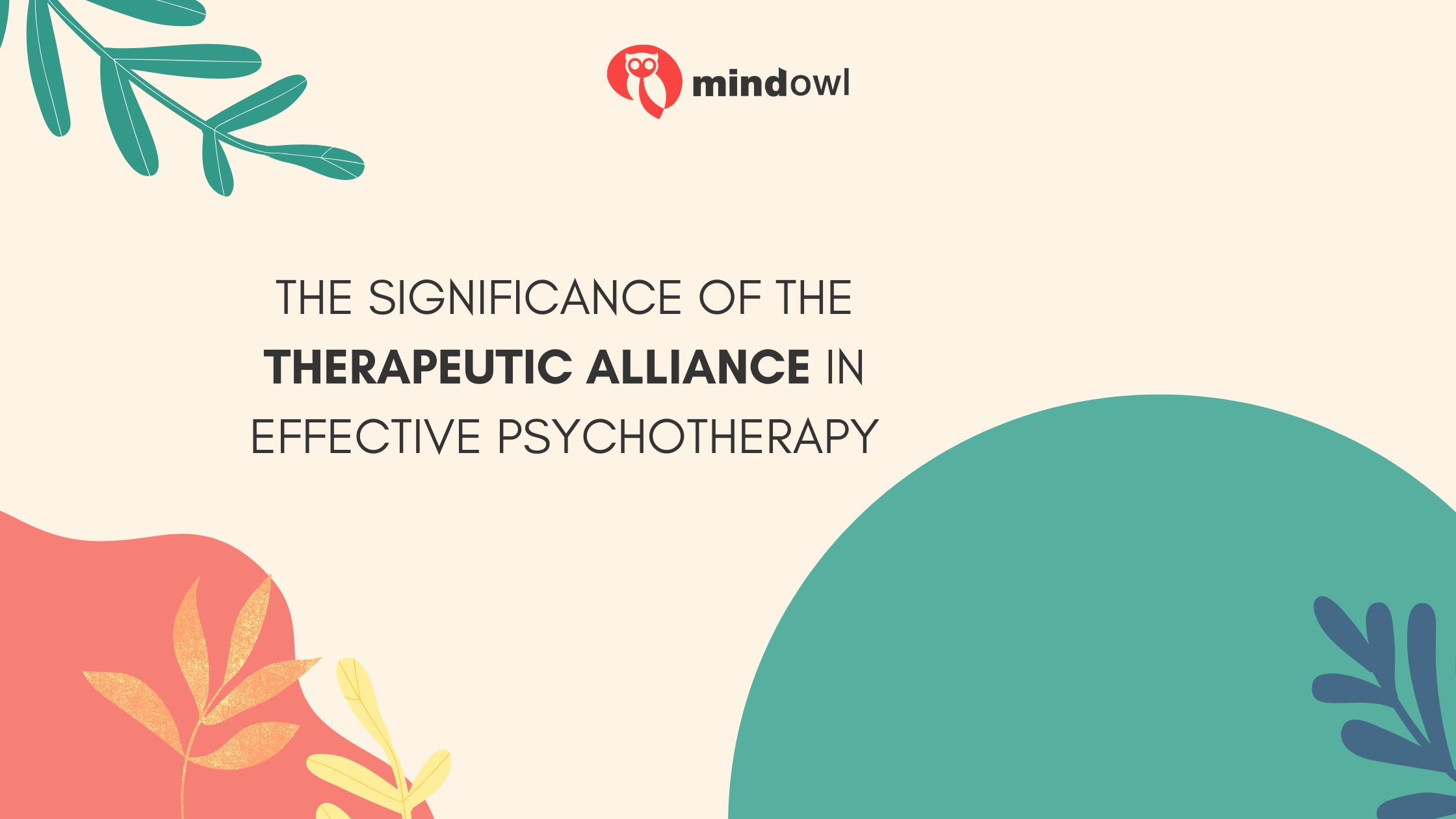Facing challenges in therapy can often stem from a disconnect between patient and therapist. The strength of the therapeutic alliance is now recognised as pivotal to successful treatment outcomes.
This blog post delves into creating and sustaining a potent bond that improves healing in psychotherapy sessions. Discover why connection is key, and stay tuned for insights that might just transform your therapy journey.
Key Takeaways
- A strong therapeutic alliance, where a therapist and patient work closely with trust and shared goals, is vital for good therapy outcomes.
- This alliance has grown to focus on teamwork rather than just the therapist’s efforts. It includes setting goals together, agreeing on tasks, and building mutual respect and empathy.
- Therapists can strengthen this bond by actively listening, showing understanding, involving clients in decisions about their treatment, and respecting their views.
- The better the relationship between therapist and client, the more likely patients will stick with therapy, feel satisfied with it, and see improvement in their symptoms.
- Measuring how well a therapeutic alliance works helps therapists improve it further. Tools like the Alliance-Outcome Rating Scale give feedback on areas like trust and partnership.

Understanding the Therapeutic Alliance
The therapeutic alliance is a collaborative and trusting relationship between the therapist and client, which is essential for effective psychotherapy. It has evolved over time and includes components such as mutual goals, trust, empathy, understanding, and agreement on the tasks of therapy.
Definition and Importance
A therapeutic alliance is the strong bond between a therapist and their client. It focuses on trust, agreement on therapy goals, and building a personal connection. This powerful relationship helps clients feel safe to open up and work together with therapists towards healing.
Having this kind of connection predicts how well someone will do in therapy. Trust plays a huge role here; it lets the patient believe in the process and make real changes in their life.
A shared belief in treatment goals means both are heading in the same direction – towards recovery.
Now let’s explore how this concept has grown over time.
Evolution of the Concept
The idea of the therapeutic alliance has grown over time. It started with a focus on deeper, often subconscious, aspects of the relationship between client and therapist. People thought it was all about the patient’s inner conflicts and how they transferred feelings from other relationships to their therapist.
Now, we see this bond in a new way.
Today, experts view the alliance as a partnership built on trust and agreement on goals. Trust forms when both sides respect each other and work together well. The partnership gets stronger when therapists show they understand their clients’ needs.
They must also make sure that their clients agree with the plan for treatment. This change shows that therapy works best as teamwork rather than just one person trying to fix another’s problems.
Components of the Alliance
As we move from understanding how the therapeutic alliance has evolved, it becomes clear why its components are vital. Let’s look at what makes up this important alliance.
- Agreeing on goals: Therapists and patients must share common objectives for therapy to be successful. They work together to set targets that are meaningful and achievable.
- Defining tasks: They also need to agree on the methods or tasks used in therapy. This involves choosing activities that will help reach the set goals.
- Building a bond: A strong personal connection between therapist and patient is crucial. They develop trust, mutual respect, and an understanding that supports healing.
- Establishing mutual trust: Trust lays the foundation for open communication. Patients feel safe sharing their thoughts and feelings when they trust their therapists.
- Ensuring mutual respect: Respect allows both parties to value each other’s views and experiences. This builds a collaborative relationship where both voices are heard.
- Cultivating empathy: Therapists show they understand and share their patients’ feelings. This helps patients feel supported and less alone in their struggles.
- Maintaining commitment: Both need to stay committed to the therapy process. They show up, participate actively, and stick with therapy even when it gets tough.
- Handling ruptures effectively: Conflict can happen in any relationship including this one. The ability to repair these ‘ruptures’ is a sign of a strong therapeutic bond between patient and therapist.
Building a Strong Therapeutic Alliance
Collaborative goal setting, shared decision making, and utilising a biopsychosocial perspective are crucial in establishing a strong therapeutic alliance. Empowering the patient to actively participate in their treatment plan also contributes to a positive therapeutic relationship.
Collaborative Goal Setting
Collaborative goal setting is key to a successful therapy. Therapist and patient work together to define clear objectives.
- Both decide what they want to achieve in therapy.
- They discuss and agree on the main issues to address.
- Goals are set that are both realistic and achievable.
- The process respects the patient’s values and preferences.
- This joint approach ensures commitment from both sides.
- Regular reviews help adapt goals as needed.
- Success is more likely when goals align with the patient’s life.
Shared Decision Making
Shared decision making strengthens the bond between therapist and client. It involves the client in the therapy journey, improving investment and adherence.
- The therapist offers information about different treatment options.
- The client shares personal values and what matters most to them in their recovery.
- Both parties discuss potential benefits and risks of each option.
- Together, they consider the client’s preferences and life circumstances.
- This process builds trust as clients feel heard and respected.
- Clients become more committed to their therapy goals, improving progress.
- It leads to better perceived alliance from both therapist and clinician viewpoints.
- Shared decision making increases satisfaction with the treatment process.
Utilising a Biopsychosocial Perspective
After deciding on goals together, therapists take into account the whole person. This means looking at their body, mind, and social world. They think about how these parts of a person’s life affect their mental health.
Therapists use what they know about a patient’s health, feelings, and relationships to guide therapy. They set goals that fit the patient’s life. The bond between therapist and patient grows stronger this way.
A good bond helps therapy work better for the patient.
Empowering the Patient
Empowering patients is crucial in building a strong therapeutic alliance. It involves helping them become more self-aware and deepen their understanding of personal issues. Through this empowerment, clients learn to explore themselves and find ways to grow stronger from within.
A therapist assists by listening actively and guiding the patient towards setting their own goals for therapy.
Encouraging patients to take part in shared decision-making also strengthens their sense of control over treatment. This participation can boost confidence and commitment to the therapeutic process.
By focusing on what matters most to the patient, therapy becomes a partnership with shared responsibility for progress and success.
The Impact of a Strong Therapeutic Alliance
A strong therapeutic alliance has been shown to lead to positive patient outcomes, regardless of the specific type of therapy being used. Research has demonstrated that the quality of the alliance between therapist and client is a reliable predictor of positive clinical outcome in psychotherapy.
Positive Patient Outcomes
The quality of the therapeutic alliance plays a crucial role in determining positive patient outcomes. A strong therapeutic alliance fosters trust, collaboration, and mutual goal setting between the therapist and the patient.
Research consistently shows that a robust therapeutic alliance contributes to better treatment adherence, improved symptom reduction, and overall satisfaction with therapy. This bond between therapist and patient helps individuals feel supported, understood, and motivated to engage in the therapeutic process.
Furthermore, patients who experience a positive therapeutic relationship are more likely to develop greater self-awareness and insight into their concerns. They tend to exhibit enhanced coping skills, increased resilience, and a deeper understanding of their challenges.
The impact of a strong alliance transcends specific psychotherapeutic modalities and is associated with favorable treatment outcomes across various conditions.
Measuring the Alliance
Measuring the Alliance
- The Alliance-Outcome Rating Scale (ARM) assesses five dimensions: bond, partnership, confidence, openness, and client initiative.
- This assessment provides a comprehensive view of the quality of the client – therapist alliance.
- Research consistently links a high – quality alliance to positive treatment outcomes across various forms of psychotherapy.
- The ARM scale helps in identifying strengths and areas for improvement within the therapeutic relationship.
- It provides valuable insight into the level of trust, mutual respect, and collaboration between the therapist and client.
- Measuring the therapeutic alliance allows therapists to tailor their approach to meet individual patient needs.

How to Strengthen the Therapeutic Alliance
To strengthen the therapeutic alliance, therapists can focus on utilising the therapeutic relationship and their role in fostering collaboration with their clients. By paying attention to building trust, promoting open communication, and creating a supportive environment, therapists can enhance the quality of the therapeutic alliance for effective psychotherapy.
Utilising the Therapeutic Relationship
Therapists can enhance the therapeutic relationship by showing empathy and understanding towards their patients. This involves actively listening to the client, acknowledging their emotions, and demonstrating genuine care for their well-being.
By creating a safe and supportive environment, therapists can help clients feel comfortable sharing their thoughts and feelings, which is essential for building a strong therapeutic alliance.
Furthermore, therapists can foster trust in the therapeutic relationship by maintaining clear boundaries while also being warm and approachable. Setting realistic expectations about the therapy process and involving clients in decision-making can empower them to take an active role in their treatment.
The Role of the Therapist
The therapist holds a crucial role in fostering a strong therapeutic alliance with the client. They work towards building trust and collaboration to ensure successful therapy outcomes.
By engaging the client in active participation, setting common goals, and sharing their beliefs about treatment objectives, therapists play an integral part in creating a positive and productive relationship.
Moreover, therapists support clients in gaining self-awareness, understanding their issues deeply, and working together on tasks related to their well-being. Their fundamental role is to empower the patient and collectively strive for improved mental health.
Therapeutic Alliance in Practice
Therapeutic alliance in practice involves the application of collaborative goal setting, shared decision making, and utilising a biopsychosocial perspective to empower the patient.
Through case studies and success stories, the impact of a strong therapeutic alliance on positive patient outcomes is highlighted, along with strategies for measuring and strengthening the alliance in therapy.
Case Studies and Success Stories
Successful therapeutic outcomes have been consistently associated with a strong therapeutic alliance. Across various forms of therapy, studies demonstrate lower symptoms and higher satisfaction when the alliance is robust.
Patients’ positive clinical outcomes are directly linked to the quality of the client-therapist alliance, emphasising its pivotal role in psychotherapy effectiveness.
Case studies further highlight how building a good therapeutic relationship leads to positive treatment results regardless of the theoretical orientation or specific approach used.
Measuring the Alliance in Therapy
Measuring the therapeutic alliance involves assessing the quality of the relationship between therapist and client. This is achieved through various tools such as the Working Alliance Inventory, which evaluates factors like agreement on treatment goals and tasks.
Additionally, studies have shown that a positive therapeutic alliance is a reliable predictor of positive clinical outcomes independent of therapy approach or intervention type.
– Utilising these measurement tools provides valuable insights into the effectiveness of therapy and helps in tailoring interventions to better suit individual needs, ultimately leading to improved patient outcomes.
Conclusion
In conclusion, the therapeutic alliance plays a significant role in the outcome of psychotherapy. Building a strong and positive relationship between therapist and client is crucial for effective therapy.
It enables mutual engagement and shared beliefs, ultimately contributing to positive clinical outcomes. The therapeutic alliance is essential in counselling and mental health, emphasising the importance of a collaborative bond between therapist and client in achieving successful treatment.
FAQs
1. What is the therapeutic alliance in psychotherapy?
The therapeutic alliance is the partnership between a therapist and client, focusing on improving health. It consists of three elements: agreement on goals, assigning tasks, and building a personal bond.
2. How does the therapeutic alliance affect therapy outcomes?
A strong therapeutic alliance can predict positive outcomes in both adult and child therapy, as it helps set clear goals and strengthens trust.
3. Can the quality of the therapist-client relationship change during treatment?
Yes, ruptures in the alliance might happen but repairing them can be part of growth in therapy.
4. Does research support the importance of a good therapeutic alliance?
Many studies show that a good relationship between therapist and patient leads to better therapy results.
5. Why do therapists pay attention to their relationship with clients?
Therapists focus on this relationship because it’s key to helping clients feel safe and supported through their treatment journey.
6. Are there tools used to measure how strong an alliance is?
Tools like the Helping Alliance Questionnaire assess how well therapists and clients work together for successful treatment outcomes.
MindOwl Founder – My own struggles in life have led me to this path of understanding the human condition. I graduated with a bachelor’s degree in philosophy before completing a master’s degree in psychology at Regent’s University London. I then completed a postgraduate diploma in philosophical counselling before being trained in ACT (Acceptance and commitment therapy).
I’ve spent the last eight years studying the encounter of meditative practices with modern psychology.

